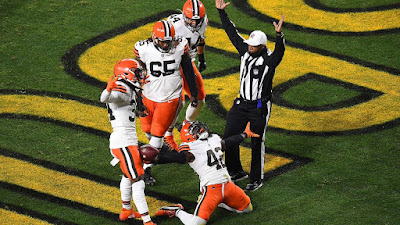The Pro Football Hall of Fame Class of 2021 was announced last night, and Peyton Manning, Calvin Johnson, John Lynch, Charles Woodson, Drew Pearson, Alan Faneca, Bill Nunn, and Tom Flores are the eight new enshrinees. All of them are deserving-- Manning excessively so, as his induction was a foregone conclusion a decade ago. As much as anyone, he defined the modern quarterback position, his teams made the postseason 13 out of 14 years, and he is, as of today, the only quarterback to win the Super Bowl with two different teams. Like Manning, Johnson defined his position-- the oversized yet amazingly athletic receiver who can outrun, outjump, and out-muscle his way to the ball. His type is all over the league now, and he was the prototype. Pearson's game was a whole different thing-- he was a master of the Paul Warfield school of pass-catching: elusive, always getting open at the right time as if he were invisible until the ball arrived. Like his rivals Lynn Swann and John Stallworth, he played his best on the game's biggest stage.
Fans as we are of defense (and, of course, the 49ers), our man Lynch's selection honors not only him, but one of the greatest defensive teams of our lifetime. Speaking of defense, Charles Woodson played eighteen-- eighteen!-- years in the defensive backfield. He started 251 out of 288 games in those 18 years; in his last season, at age 39, he started all 16. He was a nine-time Pro Bowl selection at a position where even the best players rarely last nine years. And Alan Faneca could, and probably should, have been the first offensive lineman honored as Super Bowl MVP for his tremendous play in Super Bowl XL. If it were up to us, a guard, tackle, or center would be enshrined every year.
Bill Nunn's honor comes too late for his own satisfaction, though not his family's; and in this era of hyper-awareness of such things, consider it was Bill Nunn who focused on scouting the historically black colleges, such as Grambling and Alcorn State, that brought some of the greatest players in NFL history to the Steelers. He spent 45 years with the Steelers and now will be honored with them as long as the game is played.
And Tom Flores. He gave 34 years of his life to pro football; like Mike Ditka, he was a Super Bowl player and coach. He led the Oakland Raiders to a world championship and, three years later, the Los Angeles Raiders to another. Same team, essentially, but in between those two championships he somehow maintained a culture of professionalism (shall we say, pride and poise?) while all around the team raged controversy, lawsuits, insults, jokes, and general craziness. In a game where winning is the only thing, Tom Flores' coaching career more than measures up.
Q. What do these men have in common?
Mike Holmgren, on the left, took not one, but two teams with a long and discouraging history of losing, and transformed them into Super Bowl teams. He coached in three Super Bowls, and won one. He also coached three Hall of Fame quarterbacks with great success.
Mike Shanahan, in the center, transformed a proud but struggling franchise, one branded as a perennial Super Bowl "loser," and won back-to-back Super Bowls. He also revived the career of one of the greatest quarterbacks to play the game, a first-ballot Hall of Famer.
Dick Vermeil, on the right, also took not one, but two teams with a long and discouraging history of losing, and transformed them into Super Bowl teams. He took a third underachieving franchise and revived it, too, though he didn't make the 'Bowl. And he, too, launched the storybook career of a Hall of Fame quarterback.
A. None of these men are in the Pro Football Hall of Fame.
We were ruminating this morning about Andy Reid, the great coach of the Kansas City Chiefs, who face the Tampa Bay Buccaneers in Super Bowl LV later today. Whether his team wins or loses this game, Andy Reid, we concluded, is going to the Hall of Fame. And that got us to thinking about men of similar accomplishment who ought to be there, but aren't. These three men above.
Bill Cowher is in the Hall of Fame. Tony Dungy is in the Hall of Fame. George Allen is in the Hall of Fame. They all deserve it, with two, one, and one Super Bowl teams to their names.
But if the Super Bowl is the ultimate pro football coaching achievement, then winning back-to-back Super Bowls, and coaching two different teams to the Super Bowl a decade apart, surely qualifies a coach among those who've achieved the most. It's time to give these three great coaches their due.
Dick Vermeil is 84. Let's not wait too long.





